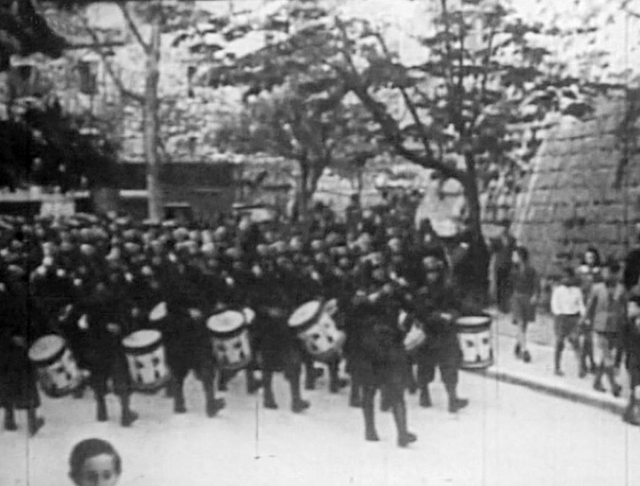Attack on Italian military band in Split

Attack on Italian military band in Split

Attack on Italian military band in Split occured on November 9th 1941 in the Croatian coastal city of Split, when the city was under Italian occupation in World War II. Group of Communist resistance members threw grenades on military band of Cacciatori delle Alpi Division of Royal Italian Army, resulting in 24 soldiers being injured. That was most spectacular of all the actions conducted by resistance movement in Split in year 1941.
Background
At the start of war, city of Split was part of semi-autonomous Banovina of Croatia within Kingdom of Yugoslavia. On April 11th 1941, five days since the start of Axis invasion of Yugoslavia, city was taken by supporters of pro-Axis Independent State of Croatia (NDH), established a day earlier in Zagreb. On April 13th members of local Communist Party and their sympathisers conducted large raid on Gripe barracks and took possesion of large cache of weapons and equipment of former Royal Yugoslav Army. Two days later Italian troops entered the city and quickly established their own administration. On May 18th 1941 that state of affairs was formalised with Rome Treaties between Italy and NDH, which made city of Split and other parts of Dalmatia officially part of Governorate of Dalmatia within Italy.
New authorities quickly began policy of Italianisation and imposing fascist ideology on the citizens, who were overwhelmingly ethnic Croats. This created deep resentment, both among local proponents of Yugoslavism and Croatian nationalism. The only faction willing to openly resist new authorities were Communists, who began to prepare for armed struggle even before Operation Barbarossa in June 1941. The activities of resistance activities were propaganda, acts of sabotage, attacks on Italian soldiers and officials, as well as local collaborators, and creation of Partisan units that were to fight guerrilla war in Dalmatian Hinterland.
Attacks were usually conducted by a strike group (Serbo-Croatian: udarna grupa) made out of 2-3 men armed with pistols or hand grenades. Sometimes they were made by individuals. The first such attacks were conducted on September 14th 1941, partly in retaliation for the death of Božo Ajduković, young resistance fighter killed while escaping arrest.
Bombing Campaign
In early October 1941 Rade Končar, general secretary of Communist Party of Croatia came to Split to personally supervise resistance activities. They were already increasing in size and intensity, to which Italians answered with increased repression, which included mass arrests and Internments, introduction of curfew and introduction of Extraordinary Tribunal for Dalmatia which handed death sentences to captured members of resistance.
Resistance intensfied bombing campaign around November 7th, trying to mark anniversary of October Revolution.
The attack
Attack occured in Tartaglia Strret (today's Tolstojeva Street) near historic centre of the city.
It was the regular route of the band which took part of flag raising ceremony in the Split Harbour.
According to later accounts, the soldiers demanded passerbys to greet the band with Roman salute and thus symbollically show allegiance to the fascist regime.
Končar planned and witnessed the attack, which was commanded by Ante Roje.
Three men were chosen for strike group - Veljko Neškovčin, Nikola Trebotić and Tomo Krstulović, while the fourth member Ranko Katunarić was tasked of providing them assistance during escape. Strike group took bombs from two female resistance members - Tonka Lukas and Neva Paić-Roje, who had brought them hidden under their skirts.
The attack occured around 17:00.
All three bombs have hit their designated targets and exploded, causing large number of injuries among Italian soldiers, and complete chaos and panic.
Končar later in his letter to Central Committee wrote: "If we had 200 armed men, we could have easily taken the whole city".
Members of strike group managed to escape except Neškovčin.
In one of the neighbouring streets he was stopped by one of the patrols.
He tried to escape, after which Italians opened fire.
He was shot five times in the stomach.
Italians quickly brought him to hospital in a hope that he would name other co-conspirators, but he lost consciousness and succumbed to his wounds on November 13th.
Aftermath
Day after the attack San Marco, local fascist newspaper, published the statement of Kvirin Klement Bonefačić, Catholic Archbishop of Split-Makarska in which condemned the attack and called local population to support Italian authorities and help them in the investigation. After the war and Communist take-over, Bonefačić claimed that the statement was forged and that he had no intention of publicly supporting the fascists.
News about the attack was reported on November 11th by main Italian radio station in Rome.
Italians responded to the attack by mass arrests.
Large number of prominent citizens, perceived to be sympathetic to the resistance or opposed to fascism, were interned to concentration camp in Lipari.
Despite being pleased by the results of the action, Končar in his letter expressed doubts about practicality of such actions and said "This should be last such attack".
Resistance fighters should gradually leave city and create bases to conduct guerilla warfare iin the hinterland.
On November 17th he was arrested.
He refused to give his identity leading to weeks and months of torture, before being shot in May 1942.
See Also
Attack near Botanical Garden